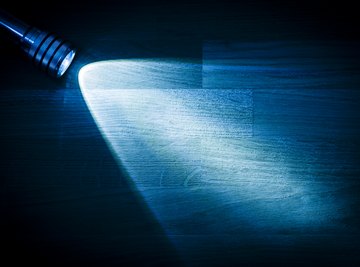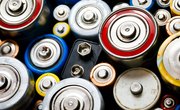
An industrial society works because of its ability to convert energy from one form to another. The energy contained in rushing water, burning coal or capturing sunlight, converted into electricity, is then stored in chemical batteries for release in a host of other applications. When you flick the switch on your flashlight, you're taking part in a series of energy conversions from the button to the beam of the light.
Thermodynamics and Energy Conversion
In a flashlight, energy must move from the power source (generally a battery) to the light source (frequently an incandescent bulb, sometimes an LED). However, every time energy changes form, some of it is lost as heat—a fundamental principle of thermodynamics. Flashlights using incandescent bulbs lose most of their energy as heat through the operation of the bulb itself. Incandescent bulbs are a good way to stay warm, but not such a good way to light your path efficiently.
The Battery
When you press the button on an electric torch or flashlight, the first energy conversion comes from the battery itself. Batteries use metal electrodes set into a chemical paste to store electricity; as the electrode oxidizes it releases electrons. In some batteries, this process is one-way. Once the battery runs down, it's useless. You can use rechargeable batteries. It's possible to add electricity into them in a process that's highly energy efficient, making them an environmentally friendly alternative to disposable alkalines.
The Bulb
An incandescent light bulb consists of a vacuum-sealed glass chamber with a thin wire filament inside. When electricity passes through the wire, resistance causes it to heat up. This conversion of electricity to heat is the second energy conversion in a typical flashlight. This is done with nearly 100% efficiency. Pretty much all of the electricity goes into producing heat, like in an electric radiator or stove top. These also generate light, as the red-orange glow of the element demonstrates.
Light and Heat
To produce light, the filament must heat up until it glows a bright white. This process is extremely energy inefficient. As much as 95% of the power applied to the bulb is lost as useless heat rather than illumination. Modern flashlights may use "light-emitting diodes," or LEDs, instead of incandescent bulbs. LEDs emit light directly, without the need to heat up an element; this allows them to skip the most wasteful energy conversion of a flashlight.
References
About the Author
Robert Allen has been writing professionally since 2007. He has written for marketing firms, the University of Colorado's online learning department and the STP automotive blog. He holds a bachelor's degree in anthropology from the University of Colorado at Boulder.
